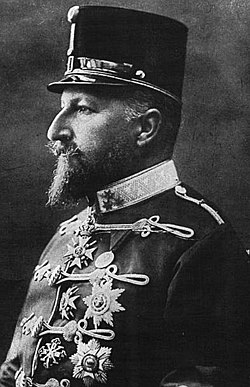11 Pułk Huzarów (austro-węgierski)

Pułk Huzarów Ferdynanda I Króla Bułgarii Nr 11 (HR. 11) – pułk kawalerii cesarskiej i królewskiej Armii.
Pełna nazwa niemiecka: Husarenregiment Ferdinand I. König der Bulgaren Nr 11[1].
Data utworzenia: 1762 rok.
Szef pułku: król Bułgarii Ferdynand I Koburg.
Skład etatowy
Dowództwo
Służby pomocnicze:
- pluton pionierów
- patrol telegraficzny
- służba zapasowa
2 × dywizjon
- 3 × szwadron po 117 dragonów
Pełny etat: 37 oficerów i 874 podoficerów i żołnierzy.
Dyslokacja w 1914 roku
Dowództwo i I dywizjon – Łańcut, II dywizjon – Przemyśl.
Przydział w 1914 roku
X Korpus, 14 Brygada Kawalerii.
Przypisy
- ↑ Za: Österreich-Ungarns letzter Krieg – według pułkownika D. Maximiliana Enhla.
Bibliografia
- Juliusz Bator, Wojna Galicyjska, Kraków 2008, ISBN 978-83-7396-747-2.
Media użyte na tej stronie
Autor:
- Imperial_Standard_of_Austria_(1828-Late_19th_Century).svg: Buho07
- Wappen_Kaisertum_Österreich_1867_(Mittel).png:
| Hugo Gerard Ströhl
(1851–1919) |
|||
|---|---|---|---|
 |
|||
| Inne nazwiska i pseudonimy |
Hugo Gerhard Ströhl | ||
| Opis | austriacki grafik, heraldyk i artysta | ||
| Data urodzenia/śmierci |
24 września 1851 |
7 grudnia 1919 | |
| Miejsce urodzenia/śmierci | Wels | Mödling | |
| Miejsce działalności | |||
| Kontrola autorytatywna | |||
Upload David Liuzzo
- Imperial Coat of Arms of the Empire of Austria.svg: Adelbrecht
- derivative work: RhoDaZZ (talk)
Imperial Standard of the Austrian Empire with Medium Coat of arms. Used until 1915 also for the Austro-Hungarian Empire. >>> See <<<
Autor: Ta ^specifik^ z W3C grafika wektorowa została stworzona za pomocą Inkscape ., Licencja: CC BY-SA 3.0
Naval Ensign of Austria-Hungary, used from 1894 to 1915.
Winter-style Uniform of an Wachtmeister (Master-Sergeant) of the Austro-Hungarian 11th Hussars Regiment – worn until about 1916








